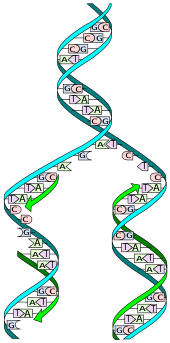Metabolism first: iron–sulfur world
The replicator in virtually all known life is deoxyribonucleic acid. DNA is far more complex than the original replicator and its replication systems are highly elaborate.
Main article: iron–sulfur world theory
Another long-standing hypothesis is that the first life was composed of protein molecules. Amino acids, the building blocks of proteins, are easily synthesized in plausible prebiotic conditions, as are small peptides(polymers of amino acids) that make good catalysts. A series of experiments starting in 1997 showed that amino acids and peptides could form in the presence of carbon monoxide and hydrogen sulfide with iron sulfide and nickel sulfide as catalysts. Most of the steps in their assembly required temperatures of about 100 °C (212 °F) and moderate pressures, although one stage required 250 °C (482 °F) and a pressure equivalent to that found under 7 kilometers (4.3 mi) of rock. Hence, self-sustaining synthesis of proteins could have occurred near hydrothermal vents.
A difficulty with the metabolism-first scenario is finding a way for organisms to evolve. Without the ability to replicate as individuals, aggregates of molecules would have "compositional genomes" (counts of molecular species in the aggregate) as the target of natural selection. However, a recent model shows that such a system is unable to evolve in response to natural selection.



Comments
Post a Comment